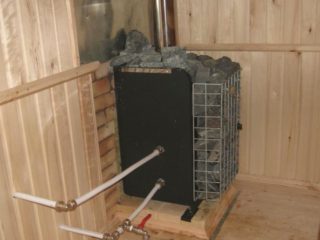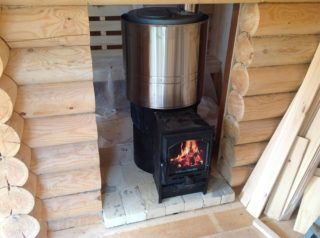In a modern bath, the base is made of concrete. This eliminates the construction of the pouring floor and requires a different mechanism to drain the water. There is an opportunity to organize a warm floor in the bath from the bath stove. This solution has its pros and cons.
Features of the underfloor heating system in the bath from the sauna stove

The features of such a heater are related to the nature of the operation of the bath. This building is not constantly heated. The underfloor heating only works during the operation of the sauna or steam room. On the one hand, this means low intensity of use, on the other hand, an increase in starting load.
The heat source in the bathhouse is a brick or metal stove. Its task is to heat the room and heat a certain amount of water. In such a device, the heat exchanger is basically absent. To connect the underfloor heating system to the furnace, both designs are modified.
- Equip a heat exchanger - a stainless steel tank or a register of pipes. A heat exchanger is placed above the firebox. From it, the pipeline is pulled down to the floor and to other heated rooms.
- Pipes serving the heat exchange tank need non-standard ones - 24 mm in diameter, not 16 mm.
- The system is equipped with a pump, since otherwise it is impossible to return the cooled liquid to the heat exchanger.
- There is no way to adjust the degree of heating. The sauna stove heats up very much and feeds practically boiling water into the system. This is unacceptable. The device is equipped with a special unit for mixing water from the furnace and return.
- Since the dimensions of the bath furnace are small, the heat exchanger is mounted here small. To compensate for the insufficient power, a battery tank is installed near the furnace and connected to a heat exchanger.
In the bath, it is recommended to install underfloor heating in all rooms. The concrete base absorbs a lot of heat in the usual way - by air heating, convection, it is not possible to warm the guest rooms well and the dressing room fails.
Advantages and disadvantages
Advantages of the system:
- walking on the heated floor in a steam room or shower is much more pleasant;
- even a low-power underfloor heating significantly accelerates the heating of rooms;
- the appearance of mold and fungi is excluded - this applies not only to the concrete floor, but also to wooden walls and cladding;
- there are no drafts;
- hot water underfloor heating does not generate electromagnetic radiation.
Disadvantages:
- In winter, water from the system must be drained, as there is a high risk of freezing pipes in an unheated building. Antifreeze can not be used.
- You need to warm up a large amount of water - a storage tank plus a warm floor in all rooms. This takes a lot more time than heating only the steam room or saunas.
- It is necessary to re-equip the sauna stove, which requires money and time.
- Do not install leaking floor.
It is possible to lay water floor heating in a concrete screed and under a wooden flooring. In the second case, reliable waterproofing is needed.
Applicable Materials
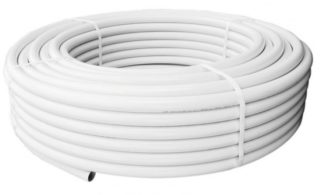
The following materials are needed for heating:
- pipes - steel and plastic for the system;
- stainless steel or brass container with a capacity of up to 100 l;
- coil - made of black or stainless steel, which serves as a heat exchanger;
- bypass and valve for adjustment;
- circulation pump;
- collector - if several rooms are heated, then a device for distributing the liquid along the contours is required;
- fittings, heaters, fasteners.
Additional materials will also be needed: reinforcing mesh, waterproofing, primers.
Preparatory work
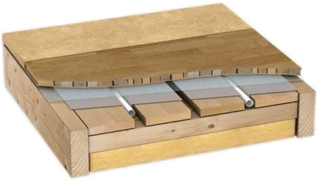
It is not easy to make a warm water floor in a bath from a stove with your own hands. If the actual installation of the system can be performed by an experienced home master, then a specialist should calculate its work, especially if several heating circuits are provided.
The choice of floor design
Underfloor heating from the stove can be equipped with various methods.
Traditional - laying in concrete screed. Pipes are placed on the base, poured with concrete. Ceramic tiles are laid on top, as it conducts heat well. A feature of installation in the steam room and shower room is the slope of the surface for water drainage.
Under a wooden flooring - pipes are laid on concrete, closed with protective materials, a wooden floor is arranged on top. According to the method of laying heating circuits, 3 types of installation are distinguished:
- Rack system - pipes are placed around the rails. The latter direct them and hold them in one place.
- Polystyrene - polystyrene substrates with recesses for pipes are laid on a concrete base. They lay the heating circuit.
- Modular - the role of the substrate is performed by mats with special fastening.
All types of such structures have a common drawback - low resistance to moisture. Floors need to be well waterproofed.
Concrete strongly absorbs heat. In order for the heating circuit to heat the room, and not the foundation, the base is waterproofed and insulated. Use a rigid, moisture-resistant heat insulator: EPSP, foam. The layer thickness is at least 5 cm. Laying is done as tightly as possible, avoiding crevices.
Nuances
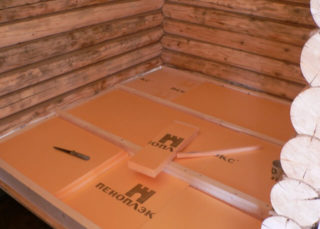
The arrangement of heating in the steam room, sauna, shower room has the following features:
- The floor is tilted. At the lowest point, a pipe is laid through which water is discharged into the sewer.
- The base must be leveled, as the heating circuit is sensitive to irregularities.
- Double waterproofing: the surface is poured with bitumen and sheets of roofing material are laid on top with an overlap. After solidification of the bitumen, the operation is repeated.
- Hard insulation is used for thermal insulation, but it is recommended to duplicate it with a reinforcing mesh.
It is possible to lay a warm floor on the ground. To do this, you need to make a sand and gravel pillow, and use expanded clay as a heat insulator.
Installation work
Laying outlines in the bath does not differ from similar work in any other room.
- After thermal insulation of the floor, the walls around the steam room are glued with a damper tape. It compensates for the thermal expansion of the concrete screed and prevents cracking.
- The tubes are placed on the floor according to the selected scheme - a snake, a snail. Fix on a grid collars.
- The tubes are connected to the manifold. Perform a test run of the system to ensure all connections are tight. Place drainage and drain funnels, if needed.
- If everything is in order, the circuit is poured with concrete or cement screed. Level the surface of the lighthouses, not forgetting to maintain a slope for draining water.
- After complete solidification of the material - at least 28 days - lay ceramic tile. As a topcoat in a dressing room or a guest room, you can use a laminate, linoleum, even wooden boards.
- Mount the second part of the system: install a heat exchanger over the furnace compartment. If this operation is not feasible, you can tie the furnace with metal pipes. Here you need experience and the ability to work with metal.
- Sauna stove low power. Warming up a large amount of water is difficult.To create a reserve, a battery tank is included in the system. It can be installed next to the stove or through the wall. It is advisable to choose option 2, since the tank is voluminous, and you need to save in a steam room.
- Mount the mixing unit - it prevents overheating of the water in the heating circuit.
- Connect systems to the collector. A three-way mixing valve is inserted into the feed pipe, here a thermal head with an external sensor is placed on the return manifold. Connect the pump.
During testing, monitor the temperature of the water. It is impossible to regulate it during operation of the furnace, so before the first use it is necessary to establish how much water needs to be taken from the return.
Terms of Use

Recommendations for using a warm floor from a brick stove do not differ much from standard ones:
- In winter, water from the pipes must be drained. If you use the bath in the cold season, you need to install another heating system.
- During operation, you need to monitor the pressure in the system. The furnace is not equipped with an appropriate sensor and does not control these indicators.
- Before starting, check the operation of the pump and valves. Leakage must not be allowed.
Repair of the warm floor is complicated. To eliminate leakage or other damage, it is necessary to remove the flooring, destroy the screed, repair the contour and repeat all the finishing work again. This is a costly and time-consuming process.
Alternatives
Instead of a water heated floor, cable or infrared can be equipped. They are independent of the sauna stove, but consume a lot of electricity. It starts easier: you do not need to wait until enough water has warmed up, you can use the bathhouse in winter, you do not need to drain the water.
Electric underfloor heating
Easier to install and cheaper option - from a heating cable. One, or better, a two-wire cable is placed on the base, fixed, filled with a screed. The system must be grounded and connected to the mains. The average power of the cable floor for the bath is 250 W per 1 sq. m
Thermomats are more convenient for installation - this is the same heating cable, but already fixed on a flexible substrate. Laying it requires experience. But it can be put not in the screed, but in a thick layer of tile glue. The height of the steam room is reduced by no more than 3 cm.
In the bath, cable models are better laid under the screed.
Infrared underfloor heating
IR film generates infrared radiation. It warms up not the air in the room, but the surface of the floor, objects and people. At a lower temperature, a person feels just as comfortable. Such models consume less electricity and are more efficient.
Plus IR films - damage independence. If at some point the carbon strips are damaged, on the other floors they function with the same efficiency.
